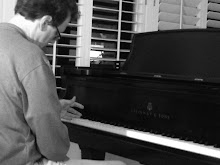Lento "not here, not now", from Sonata No. 1
Finished the slow movement of my sonata for a project at Stanford, namely a response to Mark Applebaum's Variations III.
Yes, this movement of the piano sonata requires a flute, or more specifically an alto flute. If Ives could, why can't I?
The piece is very much about the resonance of the piano, and the projected overtones of sustained and open strings, particularly those in the lower bass. The nuance suggests some ambiguity, whereby in some instances the flute line is bent sharp and other instances bent flat through the set of piano strings that remain open and sustained. The piece will vary, of course, by piano and tuning, which is part of the fun of the performance of the piece. Obviously it works best on the longest strings of a concert grand, and would be quite horrible on an upright.
Like the other movements of the sonata, this movement works with contrasting metrical structures, in this case the flute in 3 versus the piano in 5. Of course they come together in the middle stretto, both converging in 4.
The piece also applies the polytonal structure I've developed throughout the sonata. In this case, we have a progression in E Major against its retrograde in F minor and its inversion in F# minor. The middle section moves to G major and its retrograde in D minor. Etc.
Note that the mp3 here is horrific. Sibelius can't understand and project overtones, nor does it handle any of the flute quarter tones. Fortunately the piece will be performed by Beta Collide in a concert at Stanford on December 2nd. I'll update the blog with that recording when it becomes available.
not here, not now
not here, not now score
Yes, this movement of the piano sonata requires a flute, or more specifically an alto flute. If Ives could, why can't I?
The piece is very much about the resonance of the piano, and the projected overtones of sustained and open strings, particularly those in the lower bass. The nuance suggests some ambiguity, whereby in some instances the flute line is bent sharp and other instances bent flat through the set of piano strings that remain open and sustained. The piece will vary, of course, by piano and tuning, which is part of the fun of the performance of the piece. Obviously it works best on the longest strings of a concert grand, and would be quite horrible on an upright.
Like the other movements of the sonata, this movement works with contrasting metrical structures, in this case the flute in 3 versus the piano in 5. Of course they come together in the middle stretto, both converging in 4.
The piece also applies the polytonal structure I've developed throughout the sonata. In this case, we have a progression in E Major against its retrograde in F minor and its inversion in F# minor. The middle section moves to G major and its retrograde in D minor. Etc.
Note that the mp3 here is horrific. Sibelius can't understand and project overtones, nor does it handle any of the flute quarter tones. Fortunately the piece will be performed by Beta Collide in a concert at Stanford on December 2nd. I'll update the blog with that recording when it becomes available.
not here, not now
not here, not now score


0 Comments:
Post a Comment
<< Home